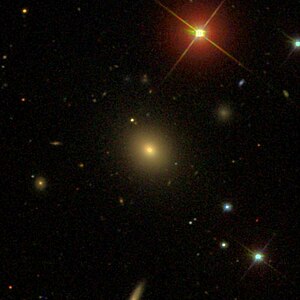NGC 391
| Galaxy data from NGC 391 |
|
|---|---|

|
|
| NGC 391 with LEDA 212660 (l) & LEDA 212659 (r) ( SDSS image) | |
| AladinLite | |
| Constellation | whale |
|
Position equinox : J2000.0 , epoch : J2000.0 |
|
| Right ascension | 01 h 07 m 22.6 s |
| declination | + 00 ° 55 ′ 33 ″ |
| Appearance | |
| Morphological type | (R ') SA0-: |
| Brightness (visual) | 13.5 likes |
| Brightness (B-band) | 14.5 mag |
| Angular expansion | 0.9 ′ × 0.7 ′ |
| Position angle | 45 ° |
| Surface brightness | 13.1 mag / arcmin² |
| Physical data | |
| Redshift | 0.017882 ± 0.000083 |
| Radial velocity | 5361 ± 25 km / s |
|
Stroke distance v rad / H 0 |
(243 ± 17) x 10 6 ly (74.4 ± 5.2) Mpc |
| history | |
| discovery | George Phillips Bond |
| Discovery date | January 8, 1853 |
| Catalog names | |
| NGC 391 • UGC 693 • PGC 3976 • CGCG 384-077 • MCG + 00-03-075 • 2MASX J01072255 + 0055331 • GC 211 • GALEX ASC J010722.51 + 005532.8 • LDCE 66 NED005 | |
NGC 391 is an elliptical galaxy of Hubble type E / S0 in the constellation Cetus south of the ecliptic . It is around 243 million light years away from the Milky Way and has a diameter of around 65,000 light years .
The object was discovered on January 8, 1853 by the American astronomer George Phillips Bond .
